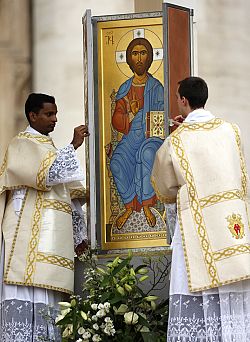Explore the mystery of the faith through mystagogy

By Timothy Johnston
Special to the Intermountain Catholic
Now that we have celebrated the great Vigil of Easter, the Church begins its 50-day festival of the Resurrection. This period is not only a time of joyful celebration, but also a time for mystagogy. Mystagogy is a very uncommon word and, in my opinion, it is one of the Church’s best-kept secrets. I have often wondered why the Church struggles to employ mystagogy.
"Mystagogy is a Greek word; its literal meaning is the ‘interpretation of mystery’ or the ‘teaching of mystery,’" according to Kathleen Hughes. It is a process of being "led into the mysteries of the faith," according Kathleen Carey, and its basic purpose is to explore or delve deeper into the liturgical actions, especially those of the Easter Vigil. This method of catechesis relies on the neophytes’ (the newly baptized) experiences of the sacramental ritual to help them come to a deeper awareness of Christ. Mystagogy had its heyday in the fourth century with preachers like Cyril of Jerusalem, Theodore of Mopsuestia and Ambrose of Milan.
In the fourth century, this type of instruction took place in the form of mystagogical homilies during the 50 days of Easter, especially during the octave (the first eight days). The goal of this method was to lead the neophyte into the heart of the Paschal mystery by reflecting on the images, poetry and rituals they had experienced. Mystagogy provided the opportunity for the mystagogue to expound on the mysteries of the faith and help the newly baptized develop a deeper understanding of the customs and teachings of the Church. This strengthened the bond between the Church and the newly baptized and brought them closer to Jesus. This reflection helped them form an intimate relationship with Christ, which would continue to be nourished by the liturgical life of the church.
The practice of mystagogy died out with the rise of infant baptism, but was revived with the publication of the Rite of Christian Initiation of Adults in 1972. Though it is the shortest section of the RCIA ritual text, it is one of the most important because it provides a formation plan for all the baptized. It is not a time to sit in a classroom and memorize more teaching, but a time to engage the risen Lord by reflecting on the gospel, sharing in Eucharist, and doing works of charity (RCIA 244). These, in turn, lead us into the heart of Christ and into a deeper knowledge of God. Unfortunately, many parishes struggle to implement this fourth period of the RCIA not only for the neophytes, but also for all the baptized.
This fourth period is not a time to sign up the newly baptized for liturgical ministry or parish clubs, but it is a time to invite the entire assembly to break open the word of God and the rituals we celebrate to discover and ponder the mysteries of Christ. It is a time for the entire community to grow closer to Christ by talking about God’s life-giving action in their midst. Our meditation on the mysteries we celebrate will invite us to be more faithful in our living of the gospel, deepen our faith, and strengthen our relationship to Christ and to his body, the church.
Today, parishes can begin to implement a mystagogical method by:
1) Inviting the parish family to study and reflect on the ritual components of the Eucharistic liturgy (e.g. introductory rites, preparation of the gifts, Communion procession);
2) Priests or deacons can prepare solid mystagogical homilies that explain the rituals we celebrated during the paschal Triduum;
3) Incorporating mystagogical reflection (a ritual experience followed by question and catechesis) into CCD classes, elementary and high school religion classes;
4) Hosting a parish service day and then gathering for prayer and reflection on the ministry.
For mystagogy to be successful, we need to practice it. We have to learn to identify and talk about our experiences and, most importantly, we must celebrate good liturgy that will invite us to contemplate God’s goodness.
For the newly baptized, this fourth period of the RCIA is supposed to last one full liturgical year, concluding with a celebration on the anniversary of their baptism, according to the National Statutes for the Catechumenate (24) concluding with a celebration on the anniversary of their baptism (RCIA 250). But in reality, like all Catholics, the newly baptized will spend the rest of their days, weeks and years returning to these celebrations, seeking a deeper relationship with God.
Timothy Johnston is Director of Liturgy for the Diocese of Salt Lake City.
© Copyright 2025 The Diocese of Salt Lake City. All rights reserved.

Stay Connected With Us